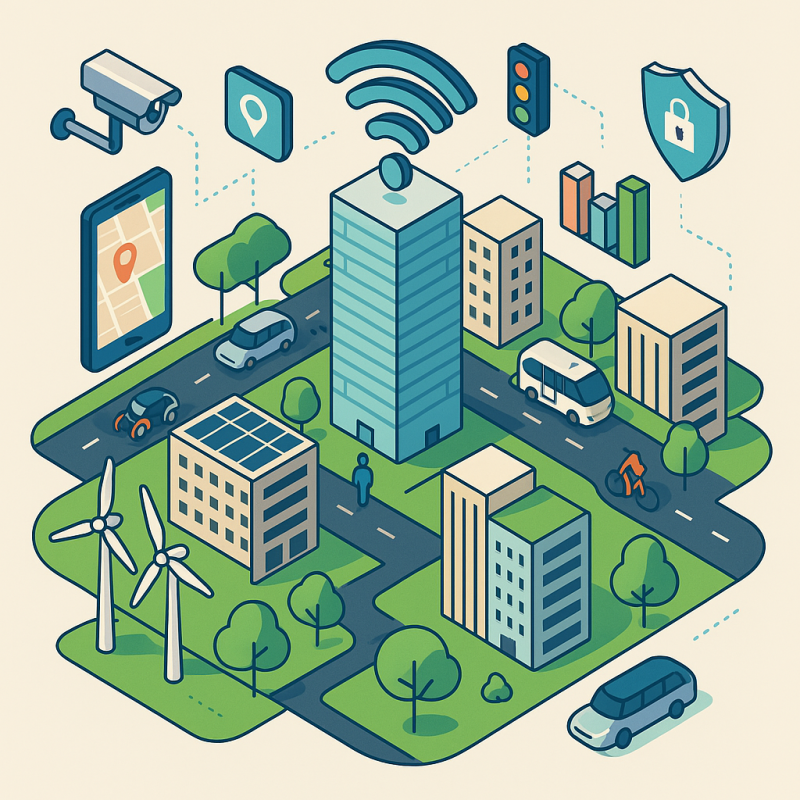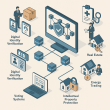Table of Contents Show
Smart cities represent the next major evolution in how we live in, interact with, and manage urban environments. As populations continue to swell and urban areas become more densely packed, cities around the world are turning to advanced technologies to improve efficiency, sustainability, safety, and overall quality of life. By combining powerful tools like the Internet of Things (IoT), artificial intelligence (AI), and real-time data analytics, smart cities are laying the foundation for a more connected and intelligent future.
In this article, we’ll dive deep into the core technologies that are driving smart cities, how they’re applied, and what that means for the everyday urban experience.
1. Internet of Things (IoT): The Nervous System of a Smart City
The Internet of Things is arguably the most essential component of any smart city infrastructure. It consists of interconnected devices and sensors embedded throughout the city to gather and share data in real-time. These devices can be found in traffic lights, streetlamps, water meters, waste bins, parking spaces, and even in buildings.
For example, in Barcelona – one of the pioneers of smart city technology – IoT sensors monitor everything from traffic and noise levels to irrigation systems and waste bins. This allows the city to adjust public services dynamically, reducing waste and saving money.
A well-connected IoT infrastructure helps cities do everything from preventing floods (by monitoring drainage systems) to improving air quality by tracking pollutant levels and adapting transportation options accordingly. It also empowers citizens by providing them with apps and dashboards to track traffic or public transport, helping them make better decisions about their commute.
2. Artificial Intelligence (AI): The Brain Behind the Operations
Collecting data is only the first step – making sense of it in real time is where AI shines. Artificial intelligence processes the data gathered by IoT devices, identifies patterns, and makes predictive decisions to streamline operations.
For instance, AI can predict traffic bottlenecks before they happen and adjust traffic lights to relieve congestion. In New York City, AI algorithms are already being used to analyze traffic camera feeds and tweak light patterns in real time to ease jams.
AI is also being used for predictive maintenance in infrastructure. Sensors on bridges, roads, and buildings collect data on structural stress or damage. AI can then forecast when maintenance will be needed, preventing failures and reducing repair costs. This “digital twin” concept – creating a virtual replica of physical assets to simulate and predict future behavior – is becoming increasingly common in smart infrastructure.
3. Data Analytics: Making Urban Intelligence Actionable
If IoT is the nervous system and AI is the brain, data analytics is the decision-making framework of a smart city. Advanced data analytics help urban planners, governments, and businesses understand long-term trends, citizen behavior, and performance of public services.
Smart cities like Singapore use data dashboards to display metrics related to everything from public health and air quality to citizen complaints and energy use. These insights allow for more transparent governance and better-targeted policy making.
Moreover, big data helps identify underserved communities or areas with rising crime or pollution. This enables city officials to allocate resources where they’re needed most, supporting more equitable urban development.
4. Smart Transportation: Moving Cities Forward
Transportation is one of the biggest challenges in any urban setting. Smart cities tackle this using a mix of real-time monitoring, automation, and connectivity to improve how people and goods move.
Real-time tracking of buses, trains, and ride-sharing services allows commuters to plan their journeys more efficiently. Dynamic traffic signal systems can respond to congestion, reducing wait times and emissions. Smart parking apps help drivers find available spots faster, cutting down on the time (and pollution) spent circling for a place to park.
A growing part of smart transportation is the use of autonomous vehicles. Cities like Phoenix and San Francisco are testing self-driving cars, which use a mix of sensors, AI, and geospatial data to navigate urban environments.
In addition, micromobility solutions – like e-scooters and shared bicycles – are increasingly integrated into urban transportation networks. These services reduce reliance on cars and promote more sustainable, flexible movement through busy cities.
5. Smart Energy Management: Powering the Future Sustainably
Cities consume more than 70% of the world’s energy and contribute to the majority of greenhouse gas emissions. Smart cities are combatting this with intelligent energy management systems that monitor consumption, optimize usage, and integrate renewable sources.
Smart grids, for instance, use IoT and AI to adjust energy delivery based on demand. During peak hours, energy can be redistributed, while off-peak times are used to recharge batteries or power up reserve systems. In Amsterdam, smart meters are deployed in homes to track usage and help residents conserve energy.
Solar panels, wind turbines, and other green energy sources are increasingly becoming part of urban infrastructure. Combined with energy storage solutions, these systems make cities more resilient to blackouts and reduce their carbon footprint.
6. Smart Waste Management: Cleaner Cities, Smarter Processes
Waste collection has traditionally been a static process – trucks follow routes regardless of whether bins are full or not. In smart cities, waste bins are equipped with sensors that detect fill levels and send alerts to waste management systems. This allows for optimized collection schedules, reducing fuel use, labor costs, and overflowing bins.
Cities like Seoul and San Diego are piloting AI-driven recycling stations that identify and sort waste, improving recycling rates. Some cities are even exploring waste-to-energy systems that convert garbage into usable energy, adding yet another layer of sustainability to urban operations.
7. Public Safety and Security: Proactive, Not Reactive
Smart surveillance is becoming more common as cities aim to keep citizens safe without intrusive measures. AI-enabled cameras can detect unusual behavior or large gatherings, enabling faster responses to emergencies or crimes.
For example, China uses facial recognition technology to monitor crowds and assist law enforcement. While these technologies raise privacy concerns, they also help track down missing persons, manage evacuations during disasters, and deter criminal activity.
Smart city platforms also integrate emergency services, so if a fire breaks out or a natural disaster occurs, response teams are automatically notified and can access real-time data on the situation – such as how many people are inside a building or the best evacuation routes.
8. Environmental Monitoring: Healthier Living Spaces
The environmental impact of urban life is significant, but smart cities are tackling this head-on through sophisticated environmental monitoring. Sensors placed throughout cities track pollutants, noise levels, and temperature fluctuations. These real-time updates are used to alert citizens with respiratory conditions, inform construction policy, or trigger traffic reduction protocols.
Copenhagen, for example, uses air quality sensors to suggest less polluted cycling routes. Paris has implemented “green zones” where vehicle access is restricted based on emissions, monitored using smart license plate recognition systems.
9. Citizen Engagement Platforms: Two-Way Communication
Smart cities aren’t just about top-down control – they also aim to empower citizens to participate in governance and city planning. Mobile apps and digital platforms enable residents to report issues, vote on local matters, and provide feedback on services.
Estonia, widely regarded as one of the most digitally advanced countries, lets citizens vote, pay taxes, and access nearly all government services online. Such digital inclusivity fosters a stronger sense of community and accountability.
Real-World Examples and What’s Next
Cities like Singapore, Barcelona, and Helsinki are at the forefront of the smart city revolution. In Singapore, autonomous buses are being tested, buildings are monitored for energy efficiency, and sensors across the island feed data to a central command hub. Meanwhile, Helsinki’s open-data policy allows citizens and startups to build new services using city data, fostering innovation.
But smart cities aren’t just for the wealthy or tech-forward. Even smaller towns are starting to implement smart lighting systems, digital permits, and traffic apps to improve quality of life. The key is scalability – technologies need to be adaptable to cities of different sizes and budgets.
Looking forward, the focus is shifting to integrating all these systems into a cohesive, interoperable platform. Interconnectivity between departments – transport, utilities, policing, and healthcare – will be crucial for smart cities to reach their full potential.
Additionally, as 5G rolls out globally, latency will drop dramatically, enabling even faster communication between smart city systems. This will enhance everything from autonomous vehicles to real-time virtual public services.
Conclusion
The future of smart cities is not a distant dream – it’s already here and expanding rapidly. As cities continue to grow, the integration of technology into every layer of urban life will become not just a luxury, but a necessity. From IoT sensors to AI decision-making, smart cities are enhancing everything from transport to trash collection, safety to sustainability.
However, with great technology comes great responsibility. Issues such as data privacy, cybersecurity, and equitable access must be addressed to ensure smart cities serve all citizens – not just the tech-savvy or wealthy.
If done right, the smart city revolution could redefine how we live together in urban environments, creating communities that are not only more efficient but also more inclusive, healthy, and sustainable.
For further reading on smart city implementations, check out:









